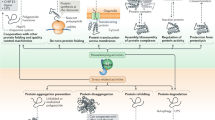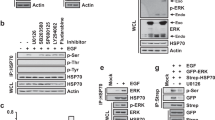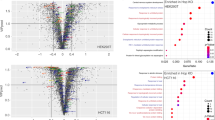Abstract
Heat shock proteins Hsp90 and Hsp70 facilitate protein folding but can also direct proteins for ubiquitin-mediated degradation. The mechanisms regulating these opposite activities involve Hsp binding to co-chaperones including CHIP and HOP at their C-termini. We demonstrated that the extreme C-termini of Hsp70 and Hsp90 contain phosphorylation sites targeted by kinases including CK1, CK2 and GSK3-β in vitro. The phosphorylation of Hsp90 and Hsp70 prevents binding to CHIP and thus enhances binding to HOP. Highly proliferative cells contain phosphorylated chaperones in complex with HOP and phospho-mimetic and non-phosphorylable Hsp mutant proteins show that phosphorylation is directly associated with increased proliferation rate. We also demonstrate that primary human cancers contain high levels of phosphorylated chaperones and show increased levels of HOP protein and mRNA. These data identify C-terminal phosphorylation of Hsp70 and Hsp90 as a switch for regulating co-chaperone binding and indicate that cancer cells possess an elevated protein folding environment by the concerted action of co-chaperone expression and chaperone modifications. In addition to identifying the pathway responsible for regulating chaperone-mediated protein folding/degradation balances in normal cells, the data provide novel mechanisms to account for the aberrant chaperone activities observed in human cancer cells and have implications for the application of anti-chaperone therapies in cancer treatment.
This is a preview of subscription content, access via your institution
Access options
Subscribe to this journal
Receive 50 print issues and online access
$259.00 per year
only $5.18 per issue
Buy this article
- Purchase on Springer Link
- Instant access to full article PDF
Prices may be subject to local taxes which are calculated during checkout









Similar content being viewed by others
References
Buchner J . Hsp90 & Co—a holding for folding. Trends Biochem Sci 1999; 24: 136–141.
Mayer MP, Bukau B . Molecular chaperones: the busy life of Hsp90. Curr Biol 1999; 9: R322–R325.
Taipale M, Jarosz DF, Lindquist S . HSP90 at the hub of protein homeostasis: emerging mechanistic insights. Nat Rev Mol Cell Biol 2010; 11: 515–528.
Young JC, Agashe VR, Siegers K, Hartl FU . Pathways of chaperone-mediated protein folding in the cytosol. Nat Rev Mol Cell Biol 2004; 5: 781–791.
Hohfeld J, Cyr DM, Patterson C . From the cradle to the grave: molecular chaperones that may choose between folding and degradation. EMBO Rep 2001; 2: 885–890.
Krukenberg KA, Street TO, Lavery LA, Agard DA . Conformational dynamics of the molecular chaperone Hsp90. Q Rev Biophys 2011; 44: 229–255.
Liu FH, Wu SJ, Hu SM, Hsiao CD, Wang C . Specific interaction of the 70-kDa heat shock cognate protein with the tetratricopeptide repeats. J Biol Chem 1999; 274: 34425–34432.
Russell LC, Whitt SR, Chen MS, Chinkers M . Identification of conserved residues required for the binding of a tetratricopeptide repeat domain to heat shock protein 90. J Biol Chem 1999; 274: 20060–20063.
Ramsey AJ, Russell LC, Whitt SR, Chinkers M . Overlapping sites of tetratricopeptide repeat protein binding and chaperone activity in heat shock protein 90. J Biol Chem 2000; 275: 17857–17862.
Peterson LB, Blagg BS . To fold or not to fold: modulation and consequences of Hsp90 inhibition. Future Med Chem 2009; 1: 267–283.
Hutt D, Balch WE . Cell biology. The proteome in balance. Science 2010; 329: 766–767.
Meggio F, Pinna LA . One-thousand-and-one substrates of protein kinase CK2? FASEB J 2003; 17: 349–368.
Blom N, Gammeltoft S, Brunak S . Sequence and structure-based prediction of eukaryotic protein phosphorylation sites. J Mol Biol 1999; 294: 1351–1362.
Scheufler C, Brinker A, Bourenkov G, Pegoraro S, Moroder L, Bartunik H et al. Structure of TPR domain-peptide complexes: critical elements in the assembly of the Hsp70-Hsp90 multichaperone machine. Cell 2000; 101: 199–210.
Zhang M, Windheim M, Roe SM, Peggie M, Cohen P, Prodromou C et al. Chaperoned ubiquitylation—crystal structures of the CHIP U box E3 ubiquitin ligase and a CHIP-Ubc13-Uev1a complex. Mol Cell 2005; 20: 525–538.
Brinker A, Scheufler C, Von Der Mulbe F, Fleckenstein B, Herrmann C, Jung G et al. Ligand discrimination by TPR domains. Relevance and selectivity of EEVD-recognition in Hsp70 × Hop × Hsp90 complexes. J Biol Chem 2002; 277: 19265–19275.
Grummt I . Life on a planet of its own: regulation of RNA polymerase I transcription in the nucleolus. Genes Dev 2003; 17: 1691–1702.
Muller P, Hrstka R, Coomber D, Lane DP, Vojtesek B . Chaperone-dependent stabilization and degradation of p53 mutants. Oncogene 2008; 27: 3371–3383.
Kajiro M, Hirota R, Nakajima Y, Kawanowa K, So-ma K, Ito I et al. The ubiquitin ligase CHIP acts as an upstream regulator of oncogenic pathways. Nat Cell Biol 2009; 11: 312–319.
Rhodes DR, Yu J, Shanker K, Deshpande N, Varambally R, Ghosh D et al. ONCOMINE: a cancer microarray database and integrated data-mining platform. Neoplasia 2004; 6: 1–6.
Miyata Y . Protein kinase CK2 in health and disease: CK2: the kinase controlling the Hsp90 chaperone machinery. Cell Mol Life Sci 2009; 66: 1840–1849.
Lees-Miller SP, Anderson CW . The human double-stranded DNA-activated protein kinase phosphorylates the 90-kDa heat-shock protein, hsp90 alpha at two NH2-terminal threonine residues. J Biol Chem 1989; 264: 17275–17280.
Mollapour M, Tsutsumi S, Donnelly AC, Beebe K, Tokita MJ, Lee MJ et al. Swe1Wee1-dependent tyrosine phosphorylation of Hsp90 regulates distinct facets of chaperone function. Mol Cell 2010; 37: 333–343.
Kundrat L, Regan L . Balance between folding and degradation for Hsp90-dependent client proteins: a key role for CHIP. Biochemistry 2010; 49: 7428–7438.
Li J, Soroka J, Buchner J . The Hsp90 chaperone machinery: conformational dynamics and regulation by co-chaperones. Biochim Biophys Acta 2011; 1823: 624–635.
Mayer MP . Gymnastics of molecular chaperones. Mol Cell 2010; 39: 321–331.
Workman P . Altered states: selectively drugging the Hsp90 cancer chaperone. Trends Mol Med 2004; 10: 47–51.
Powers MV, Jones K, Barillari C, Westwood I, van Montfort RL, Workman P . Targeting HSP70: the second potentially druggable heat shock protein and molecular chaperone? Cell Cycle 2010; 9: 1542–1550.
Pacey S, Wilson RH, Walton M, Eatock MM, Hardcastle A, Zetterlund A et al. A phase I study of the heat shock protein 90 inhibitor alvespimycin (17-DMAG) given intravenously to patients with advanced solid tumors. Clin Cancer Res 2011; 17: 1561–1570.
Keefe AD, Wilson DS, Seelig B, Szostak JW . One-step purification of recombinant proteins using a nanomolar-affinity streptavidin-binding peptide, the SBP-Tag. Protein Expr Purif 2001; 23: 440–446.
Zhang R, Mayhood T, Lipari P, Wang Y, Durkin J, Syto R et al. Fluorescence polarization assay and inhibitor design for MDM2/p53 interaction. Anal Biochem 2004; 331: 138–146.
Acknowledgements
This work was supported by grants from GACR P301/11/1678, GACR P206/12/G151, IGA NT/13794-4/2012, by the European Regional Development Fund and the State Budget of the Czech Republic RECAMO CZ.1.05/2.1.00/03.0101 and research program of the Ministry of Health of the Czech Republic FUNDIN MZ0MOU2005.
Author information
Authors and Affiliations
Corresponding author
Ethics declarations
Competing interests
Borivoj Vojtesek and Petr Muller work as consultants for Moravian Biotechnology that has developed some antibodies used in this study.
Additional information
Supplementary Information accompanies the paper on the Oncogene website
Supplementary information
Rights and permissions
About this article
Cite this article
Muller, P., Ruckova, E., Halada, P. et al. C-terminal phosphorylation of Hsp70 and Hsp90 regulates alternate binding to co-chaperones CHIP and HOP to determine cellular protein folding/degradation balances. Oncogene 32, 3101–3110 (2013). https://doi.org/10.1038/onc.2012.314
Received:
Revised:
Accepted:
Published:
Issue Date:
DOI: https://doi.org/10.1038/onc.2012.314
Keywords
This article is cited by
-
USP35 dimer prevents its degradation by E3 ligase CHIP through auto-deubiquitinating activity
Cellular and Molecular Life Sciences (2023)
-
Functional implication of heat shock protein 70/90 and tubulin in cold stress of Dermacentor silvarum
Parasites & Vectors (2021)
-
DnaJC7 binds natively folded structural elements in tau to inhibit amyloid formation
Nature Communications (2021)
-
CircRNA-100284 activates aurora kinase B by inducing methylation of HSP70 via microRNA-217 to promote proliferation of bladder cancer cells
Journal of Cancer Research and Clinical Oncology (2021)
-
The functions and regulation of heat shock proteins; key orchestrators of proteostasis and the heat shock response
Archives of Toxicology (2021)



